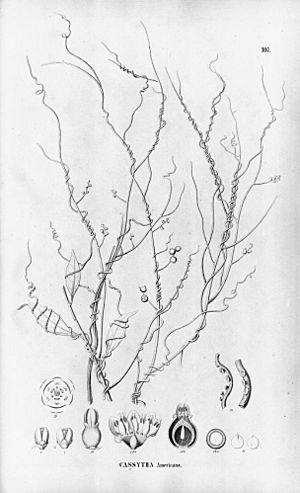Cassytha filiformis facts for kids
Quick facts for kids Cassytha filiformis |
|
|---|---|
 |
|
| Scientific classification | |
| Genus: |
Cassytha
|
| Species: |
filiformis
|
| SynonymsThe Plant List | |
|
|
Cassytha filiformis, also known as the love-vine, is a unique plant. It's a type of vine that acts as an obligate parasite. This means it must get its food and water from other plants to survive. It belongs to the Lauraceae family, which also includes laurel trees. You can find this plant all over the world in tropical areas. This includes places like the Americas, Indomalaya, Australasia, Polynesia, and tropical Africa.
Contents
What Does Love-Vine Look Like?
Cassytha filiformis is a climbing vine. Its stems can be orange or pale green. Unlike most plants, its leaves are very tiny, like small scales, only about 1 millimeter long.
Flowers and Fruit
The flowers of the love-vine usually grow in groups called spikes. Sometimes, you might find a single flower. Each flower has six small parts called tepals, which are between 0.1 and 2.0 millimeters long. After the flowers, the plant produces a fruit. This fruit is a type of drupe, which is a fleshy fruit with a hard pit inside, like a peach. The love-vine's fruit is about 7 millimeters wide.
Interesting Facts and Uses
People have known about Cassytha filiformis for a long time. An old book from 1889, called 'The Useful Native Plants of Australia', mentions this plant. It says that Cassytha species are often called "Dodder-laurel." People also used a more colorful name, "Devil's guts," because it connects bushes and trees with its vine-like cords. This could make it tricky for travelers to walk through.
Traditional Uses
The book also notes that in Southern India, Brahmins used this plant. They would use it to add flavor to their buttermilk. This shows how plants can have many different uses around the world.
Love-Vine and Gall Wasps
In 2018, scientists made an interesting discovery about Cassytha filiformis. They found out how a type of love-vine in southern Florida interacts with tiny insects called cynipid wasps. These wasps create special growths, called galls, on the leaves of host oak trees, like the Quercus geminata oak.
How the Interaction Works
New tendrils of the love-vine actively search for these galls. Once a love-vine finds a gall, it attaches itself. It uses special root-like structures called haustoria to take nutrients from the gall.
Impact on Wasps
The study showed that when love-vines attacked the galls, the survival rate for the wasps inside dropped by 45%. This means that C. filiformis has a big negative impact on the survival of these gall wasps. Scientists also found that the love-vine parasitizes other types of plants and wasp galls in the southern Florida area. This shows a complex relationship between plants and insects in nature.
- Cassytha filiformis in West African plants – A Photo Guide.
Images for kids
-
Clump of C. filiformis, on Florida Rosemary in SWFL.




